|
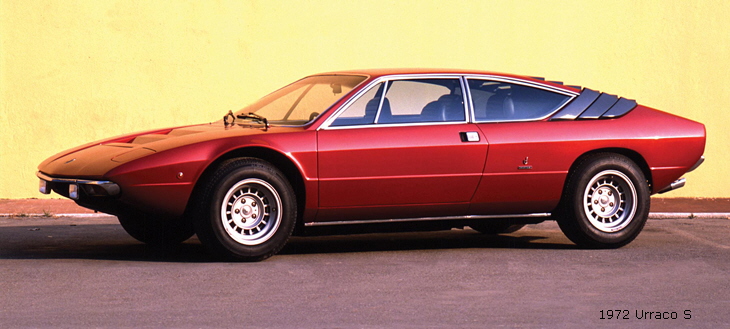
1972 With the Urraco, Ferruccio Lamborghini intended to build a more economical sports car the 2+2
Coup้ was the affordable alternative to the existing Lamborghini models. Marcello Gandini of Bertone had designed the Miura and was also responsible for the Urraco's lines. The engine was a newly developed V8,
which launched with a displacement of 2.5 liters and was expanded to 3 liters in 1974. A 2-liter V8 was only available in the Italian market. When production ceased in 1979 780 Urraco had been built.
1967-1972 Lamborghini Motorcar History
In October 1967, just three years after its hesitant debut in Turin, Lamborghini arrived at the Italian Auto
Show with an extraordinary line-up. By this time, the range of cars was truly impressive. Officially, the 350 GT was still available, but it was actually out of production by this time. The golden duo of the 400 GT 2+2
coupe and the Miura galvanised experts, attracting them to the stand of the young Bologna company that, overnight, had become the darling of all car magazines. The prestigious Touring coachwork firm also
presented one of its creations at this show, but it was its swansong: the original Flying Star, based on the front-engine chassis of the 400 GT.
The year was 1967, and Lamborghini could now look towards the future far more optimistically. The flood of orders for the Miura pumped new cash into his company, but above all it generated unparalleled interest and
publicity. At least in this, Lamborghini had been right on target: a model like this was destined to overwhelm the minds and souls of all car buffs. Lamborghini thus became a symbolic name in the auto world, the emblem
of excess, of going 'further' at all costs, of always doing more and better than any rival without preconceptions of conventional limitations. This configuration did not prevent numerous aficionados from
buying and appreciating the 400 GT, a serous and mature model by this time, but the Miura gave the company unique prestige.
Once again, the year opened with an extraordinary appearance, and this time the theme the brainchild of Bertone and Gandini was an amazing four-seater with a rear engine mounted transversally behind the axle
and sensational gull wing doors. The concept of vertically opening doors appeared for the very first time on this exotic vehicle dubbed the Marzal, and in the future this would gradually become the distinctive feature
of the top-range Lamborghinis. The Marzal was not destined for production. This did not keep the Marzal from becoming the star of many auto shows and being celebrated on the covers of international magazines.
And it was even chosen by Prince Rainier of Monaco, with Princess Grace at his side, to open the Monte Carlo Grand Prix that year. Once again, Ferruccio Lamborghini's flair for publicity proved to be exceptional.
While Dallara and Stanzani worked with the help of New Zealand test driver Bob Wallace to improve the car in production, Ferruccio ever full of ideas was pushing to show the world new models. It was not simply a
matter of vanity: the presentation of the Miura Roadster at the Brussels Car Show in 1968 also helped test customer reactions to the possibility of introducing a convertible to the range. Despite the professed
enthusiasm, however, this model received relatively few orders and as a result, it remained in the glorious stage of the show prototype without any production follow-up. More importantly, however, the Islero GT was
introduced in March of the same year. Officially presented to the press on 16 February 1968, at 6,450,000 lire it had a rather steep price tag. Nevertheless, its 300-hp engine made it an automobile that was worthy
of its prestigious name, with an increasingly comfortable and well-finished interior. This was the GT that Lamborghini had dreamed of, the natural successor to the 400 GT that had gone out of production after the
Touring coachwork company closed. The Islero GT was an impressive-looking, elegant 2+2 coupe featuring the same mechanics as the 400 it was replacing. However, Lamborghini's clientele had become accustomed
to the stylish touches of the Miura and as a result, Islero GT sales were somewhat modest.
Instead, a far different kind of success was in store for the other important novelty presented at the
Lamborghini stand at the Geneva Motor Show that year. The Espada, remotely derived from the Marzal line, was an extraordinary two-door model with a front-mounted engine and four very comfortable seats.
Featuring a 2650mm wheelbase, it flaunted an utterly original and truly innovative style. It marked the fullest expression of what was probably Marcello Gandini's most successful period in terms of creativity. The Espada
was nothing short of revolutionary and it was completely new and original, from the balance of the two main volumes to the large rear window, which was actually the hatch of the boot, and on the large flat bonnet
that opened up as a single unit, the low and tapered waistline, the rear wheel housing that partially covered the wheels and the NACA ducts on the bonnet. Once again, countless orders were placed, because the
Lamborghini name was now firmly established in the concept of the Espada was decidedly convincing.
Despite the logistical and organisational problems of the period, no one could stand idle. The production lines
of the three models (Islero, Espada and Miura) had barely been started up in 1969 when improvements began to be considered. The most important operation undoubtedly involved approving an entire series of
modifications, which were effectively required for the Miura, and incorporating them into a single new version. The outcome was the S version, created in November 1968. Its presentation was naturally a must at
the Turin Auto Show that year, and the new Miura offered customers a 370-hp engine, i.e. 20 more than the previous version. It also featured electric windows, the whole interior was more luxurious by finished and
options included air conditioning (an innovation bordering on the extravagant, at least in Europe) and natural leather upholstery. Only the chrome finish on a few minor exterior parts and a small metal S shaped like a
lightning bolt, mounted on the tail panel of the car, distinguished the new version of the Miura from the old one, which therefore ended its career. The Islero GT was subsequently elaborated, boosted in terms of
power and refinished, and as a result the GTS version was brought out on 31 May 1969. The year 1969 was marked by the temporary stabilisation of the Lamborghini model range.
The Islero GT thus left the stage quietly, though only a relatively small number had been produced (225 between Islero GT and Islero GTS version). What remained were the Miura S and the Espada, restyled and
updated in a Series II that was presented at the 1970 Brussels Motor Show, and their production gradually increased. This new series was much improved, was fitted with the 350-hp engine, more powerful ventilated
brakes and a more conventional dashboard. It was a glorious year for this model, which represented an ideal winning post not only for the company but also for Ferruccio and the objectives he had set for himself at the
start of this adventure. In 1970 alone, 228 Espadas were sold, an outstanding figure for such an expensive and important car.
Lamborghini insisted that it was essential to complement the four-seat Espada and the two-seat Miura with an 'in-between' model, a 2+2 that would represent the finest in the arena of the Italian Gran Turismo.
Bertone responded with a model that was essentially the stylistic evolution of the Islero, taking up many elements from the Espada and thus theoretically a model that would incarnate its idels. This was the
Jarama. Despite its chic launch at the 1970 Geneva Motor Show, however, it failed to make the right impression on car buffs.
By this time, around the world Lamborghini was considered the symbol of excess, of something that went beyond the philosophy and designs of other automotive companies. When it built reasonable, rational cars
that were almost normal, it did not respond to these criteria and thus did not achieve the expected success. The other great project that announced and presented in 1970 was another Lamborghini, but a radically new
and 'different' one. It was the P250 Urraco once again, the name of a fighting bull. The Urraco featured a 2.5-litre engine specially designed by Stanzani, with single overhead camshaft timing system. It was built to
criteria that would permit large scale production (by Italian sports car standards), it had a lovely line designed by Bertone, and at least on paper it offered excellent performance at a much lower price than the Miura.
To make this car, Lamborghini expanded the Sant'Agata factory, constructing a spacious new building behind the one already being used, thus adding nearly 500 square metres of new factory space. The basic
assumptions couldn't have been better: the car, presented on time at the Turin Auto Show in October 1970, aroused enormous excitement and the orders poured in.
For the history of Lamborghini and for its devotees, the creation of a racing Miura marked a very important moment, and this came about mainly through the commitment of New Zealand test driver Bob Wallace: the
Jota. For once, the name of this car did not come from the world of bullfighting, but it had a Spanish flavour nonetheless, since the Jota is a typical dance in that country. The name change was highly significant: in
fact, Wallace's work was not merely cosmetic, as was the case with many other designers. He instead created a race car that borrowed only the mechanical configuration from the Miura, particularly the engine
transversely mounted in the mid-rear position, and the general lines of the body. Instead, the chassis was completely new, made of tubular elements and bent metal sheets, which were welded and glued for improved
rigidity. The body was made of aluminium, the entire chassis had been significantly improved, and the engine power, substantially increased, could crank out 440 hp at 8500 rpm.
The car, thus modified and lightened to weigh just 890 kilograms offered outstanding performance, with acceleration from zero to 100 km/hour in just 3.6 seconds! Externally, the Jota could be recognised
immediately because of its streamlined headlamps under Plexiglas covers, the broader wheel housings, particularly the rear ones, the elimination of the grilles on the front hood, the small sliding side windows and
the distinctive magnesium alloy wheels. It was an unmistakable, ultra-fast and brutal car, the ideal prelude to Lamborghini's entry to the world of racing. Unfortunately, the Jota had no follow-up. Nevertheless, the
Bologna entrepreneur, who in the meantime inaugurated other industrial activities in the sectors of hydraulics and other components, was not one to rest on his laurels. He continued to spur on his technical staff, who -
truth be told - needed no encouragement, in order to introduce a complete range of modifications for the Miura (in part derived from the carmaker's experience with the Jota), thus creating the definitive and
absolute version of this legendary model: the SV, presented at the Geneva Motor Show in 1971.
Despite this successful evolution, the SV exhibited at the 1971 Geneva Show virtually went unnoticed, and
very few credited it with the importance that, over the years, this nearly perfect version of Lamborghini's super car would acquire. The reason was quite simple: everyone was distracted by an even more spectacular
and extraordinary car that proved to be the true star, not only at the Lamborghini stand but throughout the entire show. It was a car created through a stroke of combined genius by Lamborghini and Bertone, which
the company's trusty deputies Stanzani and Gandini brought to life in record time, as usual. This utterly spectacular model was the LP 500, better known as the 'Countach'.
This was a truly revolutionary car, starting with its line, which was the first thing that left all those who saw it at that Motor Show speechless with admiration. Its sleek and aggressive snout, the flat windscreen
connected seamlessly to the front bonnet on one end and the roof on the other, the roof that - in turn - continued over the engine hood, forming a single gradual curve that went from the front fenders to the tail
panel of the body. This marked an innovative, astonishing and completely new stylistic concept. Once again, Lamborghini upset preconceived notions.
The changes that were taking place around Lamborghini, however, reflected the social situation around the world, particularly in Italy. Labour unions' unrest in that period created a difficult situation in all factories,
particularly at engineering companies in northern Italy, in which the owner's control was openly contested and proper organisation became increasing difficult. For Lamborghini, long accustomed to the direct,
sometimes rough, somewhat paternalistic but attentive control of his factories, this new situation became intolerable. In 1972 he sold his majority stake to the Swiss Georges-Henri Rossetti, and the following year he
sold his remaining shares to a friend, Ren้ Leimer. Thus, the company founder - the man who had been the driving force behind its extraordinary, vital explosion during the first eight years - left the scene for good.
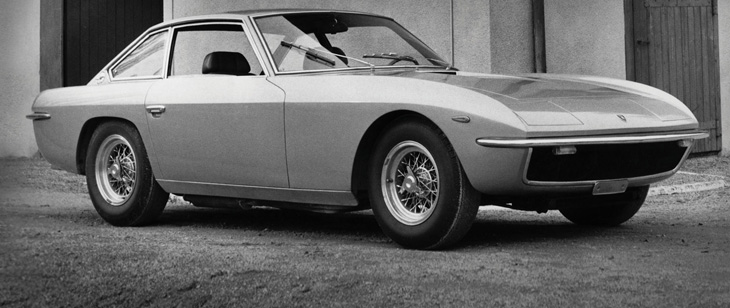
1968 The Islero was the GT 400's successor and debuted at the 1968 Geneva Auto Show. The 2+2 Coup้
highlighted Lamborghini's expertise in terms of the engine output, the chassis and the overall performance. Production ceased after 225 models of which the last 70 were put on the market in 1969 with a few changes
to the body and luxurious interiors in the Islero S version.
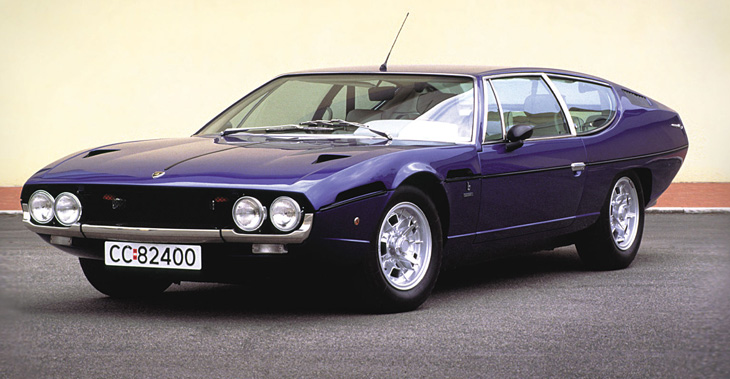
1968 During its ten-year production the Espada received several modifications. While the engine and the
interior were changed with each new series, the design of the bodywork remained almost untouched. There just was no need for big redesigns since the Espada was a real eye-catcher right from the start.
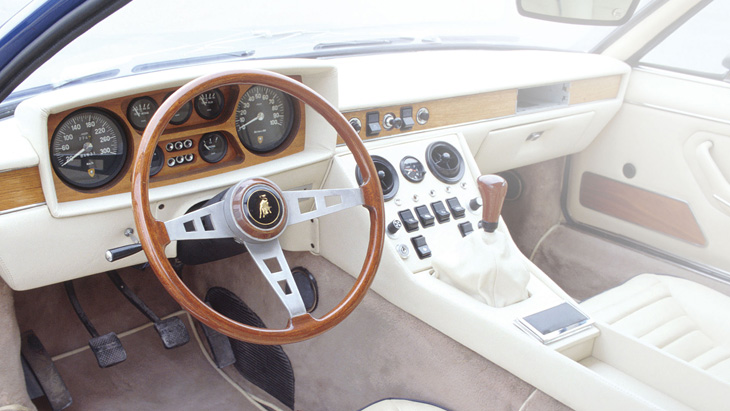
1968 The Espada could effortlessly reach a maximum speed of 250 km/h. Depending on the version, the
4-liter 12-cylinder engine developed between 325 and 350 HP and was praised equally for its sound and power. With its large passenger compartment, the spacious trunk and the strong engine the Espada was the
embodiment of the Italian Gran Turismo, a luxurious car for grand tours.
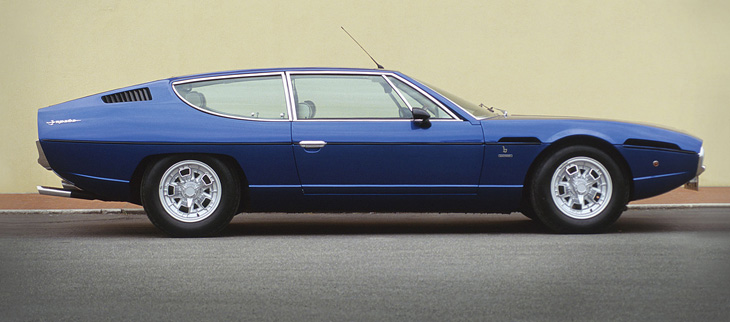
1968 At the 1968 Geneva Auto Show company founder Ferruccio Lamborghini presented the four-seater he
had demanded in order to expand his lineup of sports cars. Marcello Gandini of Bertone had designed the Espada a two-door Coup้ that offered four comfortable seats and plenty of space for luggage. With a total
number of 1,227 units the Espada became Lamborghini's bestseller from 1968 to 1978.

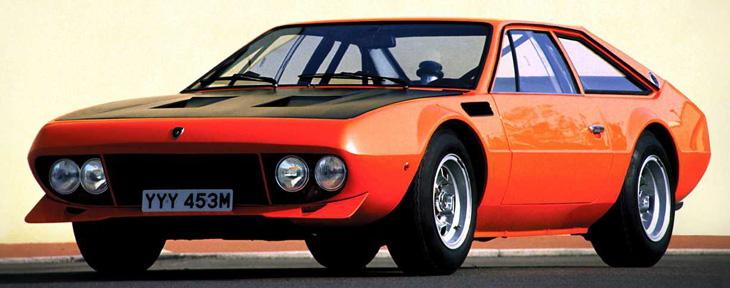
1970 Conceived for the "gentleman" driver, this car represented an ideal mix of elegance and power. The
Jarama was the evolution of the Islero and one of Ferruccio Lamborghini's favorites he appreciated the excellent combination of a strong engine and luxurious comfort, without the focused attention that a Miura or
an Espada stirred up.
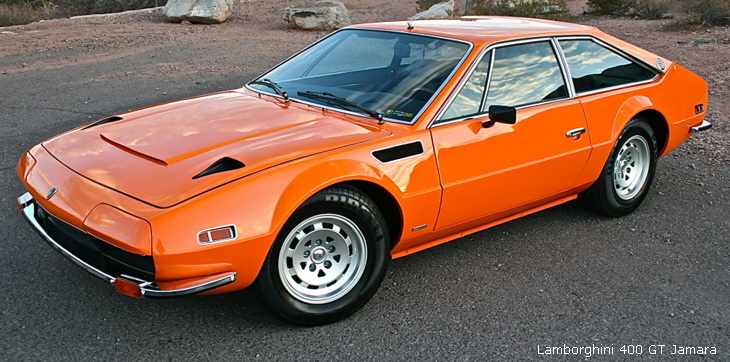
Lamborghini 400 GT Jamara
- Production 1970-1972 (177 built)
- Layout FR Engine(s) 3,929 cc (239.8 cu in)
- 3.9L 350 bhp V12 engine with six Weber carburettors giving a top speed of 162 mph
- Transmission(s) 5 speed manual Length 4,483 mm (176.5 in)
- Width 1,822 mm (71.7 in)
- Height 1,187 mm (46.7 in)
- Curb weight 1450 kg
Lamborghini V12
It was exactly this engine that captured the imagination of show-goers at the 1966 Geneva Auto Salon in the Lamborghini Miura. Although its main features were already familiar from the 400 GT, this time the four-liter 60 twelvecylinder was mounted transversely behind the cockpit, with transmission and differential in
a single unit fixed directly to the frame.
The 320 hp made the series production Miura that followed the fastest production car of its time with a
stated top speed of more than 280 km/h and, with that, the first true super sports car. This engine was further developed over the years, with several iterations featuring in the Miura S (370 hp at 7,000 rpm, 285
km/h) and Miura SV (385 hp, 300 km/h). In the Miura Jota, a one-off made for racing, the V12 generated 440 hp at 8,500 rpm. However, applications for the four-liter were not limited to the mid-engine Miura. In the
front-engine Islero, introduced in 1968, and in the 400 GT Jarama, it produced 350 hp, while in the futuristic Espada the figure was 325 hp (later also 350 hp). In 1974, the Espada also saw an automatic transmission
offered for the first time.
The generational shift from the Miura to the new LP400 Countach took place in the early seventies. 1971
brought the prototype with a breathtaking, edgy form, the genes of which would ultimately re-emerge forty years later in present-day Lamborghini super sports cars. Marcello Gandini's design was a fitting outfit for a
five-liter version of the V12.
However, this engine was dropped from the series production model in 1973 in favor of a further evolution of
the four-liter unit. In the 1973 Countach still without the "wing" or spoiler of the eighties it was longitudinally mounted behind the driver, where it generated 375 hp at an impressive 8,000 rpm and reached
a top speed of 300 km/h. The years that followed saw the Countach engine undergo a series of evolutionary developments, although still based on the familiar cornerstones of the first V12 unit. It was in 1985 that the
Countach Quattrovalvole took displacement over the five-liter mark for the first time (5,167 cm3) and as the name implies featured a four-valve cylinder head. Output was an impressive 455 hp at 7,000 rpm.
In 1986, the five-liter V12 was presented with a completely new application the Lamborghini LM002 Truck,
may also have had the 450 hp engine mounted up front, but the 2.7 ton automobile was the first and only SUV produced by the brand, a four-door all-terrain vehicle. The late eighties saw the amazingly
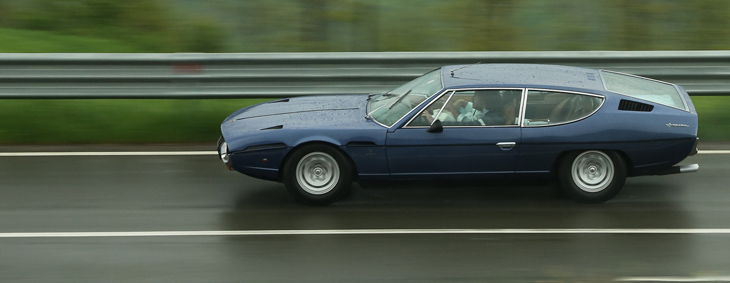
|








